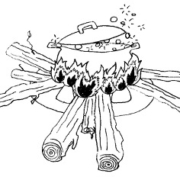The Not-Stove Intervention
Cooking outside
When the air exchange rate is doubled, the concentration of smoke is reduced by half. The average house in low middle income countries is estimated to have around 12 air exchanges per hour (ISO 19867-3). When ARC measured the air exchange rate outdoors in a gentle breeze it was found to be about 120 per hour. Exposure to smoke could theoretically be dramatically reduced by moving outside.
Changing stoves costs money and the transition to an improved stove is often a time consuming process. ISO reports that even stoves with chimneys (that often leak) only reduce concentrations of smoke in houses by around 75%. Experimenting with increasing the air exchange rate is probably the most cost-effective intervention to protect health.
When we went to villages where women cooked outside, Dr. Winiarski would frequently ask the women if digging a well, etc. might be more important than new Rocket stoves. That is one of the things that we loved about Larry!



Leave a Reply
Want to join the discussion?Feel free to contribute!